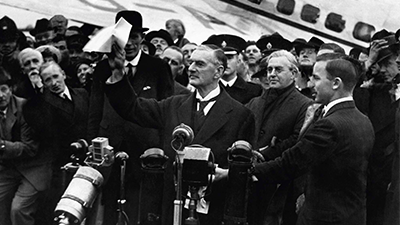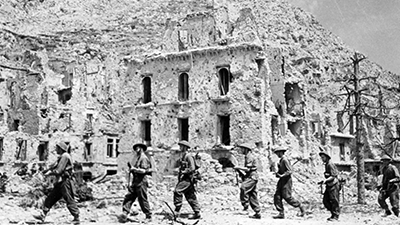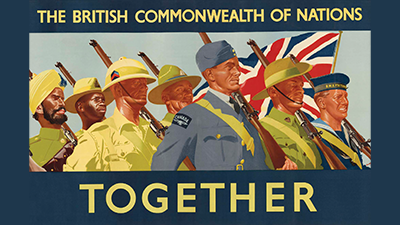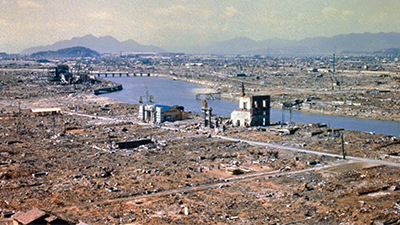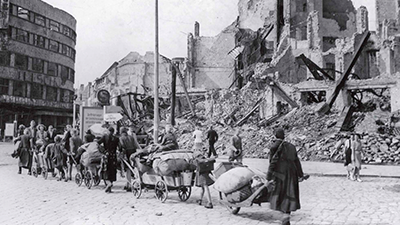The Second World War
Teacher Resources
Driving Question: What were the causes of the Second World War?
There has never been a war on the scale of World War II. It transformed global power, devastated economies, and unleashed a horrifying age of weapons of mass destruction. This lesson unpacks the complex causes and progression of the war, and explores its profound consequences.
Learning Objectives:
- Use evidence to understand how and why diplomacy failed to prevent a second world war.
- Use the historical thinking practice of causation to analyze global factors that led to the Second World War.
- Use the historical thinking practice of claim testing to identify, assess, and use evidence when evaluating and making claims.
Vocab Terms:
- antisemitism
- appeasement
- campaign
- mobilization
- pacifism
- total war
Opener: The Second World War
To teach this lesson step, refer to page 3 of the Lesson 8.6 Teaching Guide.
Interested in how other teachers implemented Who am I? Read through this forum thread for ideas and examples of student work.
Before learning how global war broke out, take a moment to reflect on the complex nature of identity. By exploring how identities overlap, you’ll start thinking about how belonging, community, and perspective shaped the choices people—and nations—made in the lead-up to World War II.
The Road to Ruin
The scenario: Students role-play Neville Chamberlain as he made five crucial decisions about how to respond to Hitler in the lead-up to World War II:
- Anschluss (annexation of Austria), March 1938
- Munich Agreement, September 1938
- Occupation of Czechoslovakia, March 1939
- Anglo-Polish Guarantee, March 1939
- Invasion of Poland, September 1939
Prompt AI to provide students with a list of what Chamberlain knew at each step (military strength, public opinion, alliances, and Hitler’s demands). Using answers to these questions—and carefully fact-checking—students then generate arguments for and against appeasement, defending their decisions in a class discussion.
Why this is genius: By stepping into the shoes of a historical actor, students practice historical empathy. AI supports their research, but students must determine what evidence mattered most at the time.
As fascist leaders rose to power, democratic nations faced difficult choices. Discover how efforts to keep peace through compromise ultimately shaped the path to another war and sparked lasting debate.
-
Guiding Questions
-
Before you read
Preview the questions below, and then skim the article. Be sure to look at the section headings and any images.
While you read
Look for answers to these questions:
- What did appeasement mean in this period?
- Why did Chamberlain support appeasement?
- How did appeasement affect Hitler’s views of Britain and France?
- How has appeasement been remembered since World War II?
After you read
Respond to these questions: Do you think France and Britain could have prevented a war with fascist Germany? Why or why not?
Axis vs. Allies
To teach this lesson step, refer to page 4 of the Lesson 8.6 Teaching Guide.
Still looking to improve students’ causation skills? Support them by using the Causation Feedback Form to help them understand where they are and where they should be going with this skill.
World War II was a massive and complicated conflict. In this section of the lesson, you'll trace its key turning points, economic demands, and global alliances while also working to untangle the many causes that led to war in the first place.
-
Guiding Questions
-
Before you read
Preview the questions below, and then skim the article. Be sure to look at the section headings and any images.
While you read
Look for answers to these questions:
- Why is there debate about when World War II began?
- Who dominated the early years of the war in Europe?
- What led the Soviet Union to enter the war?
- Why did the United States join the war?
- What turned the tide of the war around 1942?
After you read
Respond to this question: How does weaving personal stories, such as Getz’s grandfather’s experience, into the broader narrative of World War II affect your understanding of the war?
-
Guiding Questions
-
Before you read
Preview the questions below, and then skim the article. Be sure to look at the section headings and any images.
While you read
Look for answers to these questions:
- What is a “total war economy”?
- Why did Japan pursue conquest and colonization in Asia?
- How did the Soviet Union’s government help direct resources toward the war?
- How did the war impact the US economy?
- Why did Britain, unlike Japan, not need to conquer new territories to support its war effort?
After you read
Respond to this question: What nineteenth-century developments gave the Allied powers an edge in production and distribution during the war?
The Costs
To teach this lesson step, refer to page 9 of the Lesson 8.6 Teaching Guide.
Looking for A Slightly Different Twist on Claim Testing – Global Conflict? Look no further than this Community Forum thread.
In this part of the lesson, you’ll examine the devastating human and environmental costs of the war, including the use of nuclear weapons. Then you’ll test claims about the global impact of the conflict and reflect on how the choices made during the war reshaped the future.
-
Guiding Questions
-
Before you read
Preview the questions below, and then skim the article. Be sure to look at the section headings and any images.
While you read
Look for answers to these questions:
- How did nuclear science reach the United States before the bombs were developed?
- What is one argument for why President Truman decided to drop the atomic bombs?
- What alternative explanation does Gar Alperovitz offer for Truman’s decision?
- According to Hasegawa, what led Japan to surrender?
- Besides destruction, what other global consequences resulted from the development of nuclear weapons?
After you read
Respond to this question: Which explanation for the use of atomic bombs do you find most convincing, and why?
Closer: The Second World War
To teach this lesson step, refer to page 13 of the Lesson 8.6 Teaching Guide.
Now that you’ve explored the many causes of the Second World War, consider: could it have all been avoided?
Counting the Cost
To teach this lesson step, refer to page 14 of the Lesson 8.6 Teaching Guide.
Together, these materials invite you to rethink the causes, consequences, and historical context of the conflict. A powerful visual shows just how many lives were lost, while a thought-provoking article argues that World War II may have been part of a longer, 30-year global crisis.
-
Guiding Questions
-
Before you watch
Preview the questions below, and then review the transcript.
While you watch
Look for answers to these questions:
- How did military and civilian casualties differ during the war?
- Which country lost the most soldiers and civilians in the war, and why?
- Which side intentionally targeted civilians?
- Was World War II the deadliest war in history?
- What is meant by “The Long Peace”?
After you watch
Respond to this question: Why do you think major wars have become less frequent and less deadly since World War II?
Key Ideas
-
Guiding Questions
-
Before you read
Preview the questions below, and then skim the article. Be sure to look at the section headings and any images.
While you read
Look for answers to these questions:
- How did nationalism connect World War I and World War II?
- What role did empires and colonialism play across both wars?
- How did the post–World War I treatment of Germany contribute to the outbreak of World War II?
After you read
Respond to these questions: Do you think viewing 1914 to 1945 as one long war helps us better understand the causes and consequences of global conflict? Why or why not?



